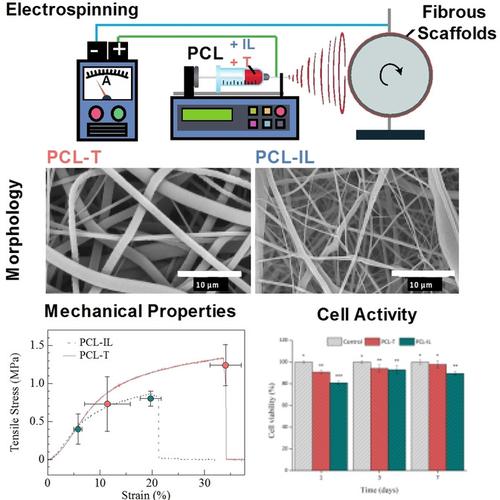当前位置:
X-MOL 学术
›
ChemistrySelect
›
论文详情
Our official English website, www.x-mol.net, welcomes your
feedback! (Note: you will need to create a separate account there.)
Electrospun Polycaprolactone Scaffolds Using an Ionic Liquid as Alternative Solvent: Morphometric, Mechanical and Biological Properties
ChemistrySelect ( IF 1.9 ) Pub Date : 2020-11-27 , DOI: 10.1002/slct.202002399 Bernardo A. Da Silva 1 , Alexsandra Valério 1 , Karina Cesca 1 , Dachamir Hotza 1 , Sergio Yesid Gómez González 1
ChemistrySelect ( IF 1.9 ) Pub Date : 2020-11-27 , DOI: 10.1002/slct.202002399 Bernardo A. Da Silva 1 , Alexsandra Valério 1 , Karina Cesca 1 , Dachamir Hotza 1 , Sergio Yesid Gómez González 1
Affiliation

|
Ionic liquids (IL) are a greener alternative to aggressive organic solvents used for biopolymers dissolution in the electrospinning process. Nevertheless, the effect of IL on the properties of the electrospun materials is still a gap. In this work, we obtain polycaprolactone (PCL) electrospun mats using two solvents, either trichloromethane (CHCl3) – a conventional toxic and carcinogenic solvent – or 1‐butyl‐3‐methylimidazolium chloride ([Bmim]Cl), an ionic liquid. The differences between the respective electrospun products were assessed through the scaffold's morphology, mechanical properties and cytotoxicity. The use of IL resulted in the formation of textured thinner fibers, enhancing the surface area in 43 %. IL induced a lower rupture stress and elongation of the mats of 34 and 39 %, respectively, while the elastic modulus and yield stress did not present significant differences. The cytotoxicity assays using L929 cells detected a number of viable cells slightly higher for the scaffold produced with IL. Cell interaction tests also revealed that L929 cells adhere and proliferate on both scaffolds. However, the cell adhesion was higher for the mats fabricated using IL. Beyond the results, this work sheds light on the pros and cons of tissue engineering scaffolds produced with the aid of less hazardous solvents.
中文翻译:

使用离子液体作为替代溶剂的电纺聚己内酯支架:形态,机械和生物学特性
离子液体(IL)是用于静电纺丝过程中生物聚合物溶解的侵蚀性有机溶剂的绿色替代品。然而,IL对电纺材料性能的影响仍然是一个空白。在这项工作中,我们使用两种溶剂三氯甲烷(CHCl 3)–常规的有毒致癌溶剂–或1-丁基-3-甲基咪唑鎓氯化物([Bmim] Cl),一种离子液体。通过支架的形态,机械性能和细胞毒性评估各自的电纺产品之间的差异。IL的使用导致形成纹理化的较细纤维,将表面积增加43%。IL分别引起较低的破裂应力和毡垫的伸长率,分别为34%和39%,而弹性模量和屈服应力没有显着差异。使用L929细胞的细胞毒性测定法检测到,用IL产生的支架中的活细胞数量略高。细胞相互作用测试还显示,L929细胞在两个支架上均粘附并增殖。然而,使用IL制造的垫的细胞粘附性更高。
更新日期:2020-11-27
中文翻译:

使用离子液体作为替代溶剂的电纺聚己内酯支架:形态,机械和生物学特性
离子液体(IL)是用于静电纺丝过程中生物聚合物溶解的侵蚀性有机溶剂的绿色替代品。然而,IL对电纺材料性能的影响仍然是一个空白。在这项工作中,我们使用两种溶剂三氯甲烷(CHCl 3)–常规的有毒致癌溶剂–或1-丁基-3-甲基咪唑鎓氯化物([Bmim] Cl),一种离子液体。通过支架的形态,机械性能和细胞毒性评估各自的电纺产品之间的差异。IL的使用导致形成纹理化的较细纤维,将表面积增加43%。IL分别引起较低的破裂应力和毡垫的伸长率,分别为34%和39%,而弹性模量和屈服应力没有显着差异。使用L929细胞的细胞毒性测定法检测到,用IL产生的支架中的活细胞数量略高。细胞相互作用测试还显示,L929细胞在两个支架上均粘附并增殖。然而,使用IL制造的垫的细胞粘附性更高。


















































 京公网安备 11010802027423号
京公网安备 11010802027423号